Carrying coach’s lacrosse lessons into life
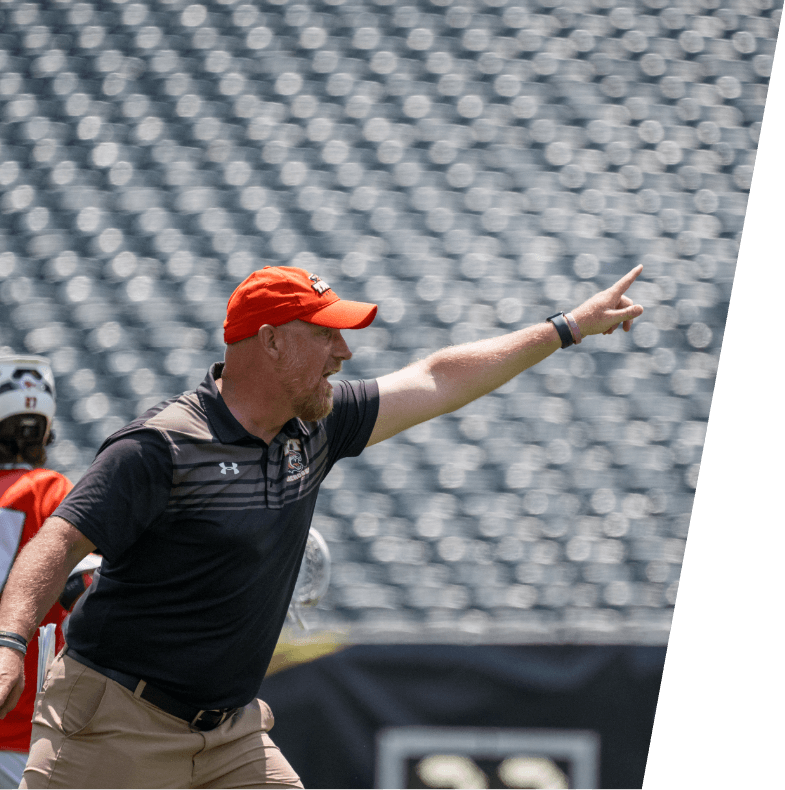

When David Burke ’11 (civil engineering technology) is leading multimillion-dollar construction projects for The Whiting-Turner Contracting Co., the lessons he learned playing lacrosse under RIT Coach Jake Coon about integrity and treating people fairly guide his actions.
Chris Cherami ’11 (graphic design) often thinks about Coon’s ability to get members focused on one goal, especially when he created his adventure bag company MULUS.
Ian Dominick ’13 (mechanical engineering) knows from his years playing RIT lacrosse that no matter how tired he is, he can still find a way to get something done as a sales engineer for Hobbs & Associates.
Burke, Cherami, and Dominick were all members of Coon’s first team at RIT in 2010. And they, like other lacrosse alumni, carry these lessons with them in their professional and personal lives.
Coon has turned RIT men’s lacrosse into a national powerhouse. Consider the statistics. He has the highest winning percentage (.903) in all NCAA divisions.
Every year, his teams have appeared in the NCAA Division III Tournament and two have won national championships. He has coached 108 All-Americans, athletes considered to be the best in their sport.
Coon, though, prefers to talk about the 15 classes of leaders he helped shape and the assistant coaches who worked with him to build a top-notch program. The key to their success, he says, has always been balance. First comes family, followed by academics. Then there’s lacrosse and a social life.
Jacqueline Nicholson, RIT’s executive director of Intercollegiate Athletics, said that recipe for success involves Coon being a father figure to players while they are in school and then transitioning into a friend role after graduation.
“He is building not just that community that is there for four years but a lacrosse community that is there for a lifetime,” she said.
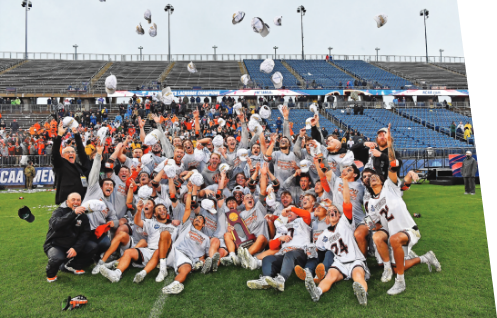
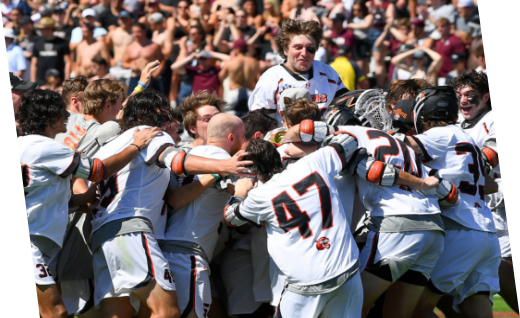

Coming to RIT
Coon considered playing lacrosse at RIT in the late 1990s. But the native of 6,000-population Homer, N.Y., found a better fit at Nazareth College (now Nazareth University) across town in Rochester.
He was a star goalie and four-time All-American at Nazareth and ended up staying there after graduation from 2001 to 2005 to coach the goalies and defense.
Coon also played professionally for the Rochester Knighthawks. He had moved on to defensive coordinator at the University of Massachusetts when the RIT head-coaching position opened.
Coon applied, he said, because he was interested in moving his young family back to upstate New York and becoming a head coach at a growing university. Initially, though, RIT wasn’t super interested in him.
“I was somewhere around the fourth pick,” Coon said, grinning.
Cherami, who was a player representative on the hiring committee along with Burke, remembers thinking that Coon was the change the players had been seeking.
“Probably the best thing he did in that interview with us, which is probably the biggest thing to our success, is that he wanted to know what we were thinking,” the Jersey City, N.J., resident said. “He said, ‘I am not here to make this my show.’”
By the time Coon started that fall of 2009, his players had already begun fall ball, the period when spring sports are allowed to have formal practices.
Burke remembers driving from a co-op with Whiting-Turning in Baltimore to RIT for one of Coon’s first practices.
“It was a sticker shock,” said Burke, who now lives in Charlotte, N.C. “Jake came in and just lit a fire under everybody. We knew this guy was legit.”
The fire was in the form of conditioning.
Coon’s philosophy has always been that the team in the best shape is going to have success.
“We jokingly called him the time bandit,” said Dominick, who lives in Baltimore. “We would show up for practice and before we knew it four hours had disappeared.”
There was also another element that changed the dynamic of Coon’s introduction to RIT.
Player Willie Rago, who was in his first year, was diagnosed with cancer and was unable to compete. Rago died in September 2010.
“One of our main pillars is being thankful for the opportunity to play and that was definitely true immediately the first year in our program,” Coon said. “The guys had a deeper understanding of what playing the game really meant.”
Although it was a tough year that started with two losses, Coon’s first team ended up winning the conference championship as well as its first game in the NCAA Tournament.
Coon gives the credit to the players, who he says set the tone for the next 14 years.
“This program wouldn’t be where it is today if those guys took a different path.”
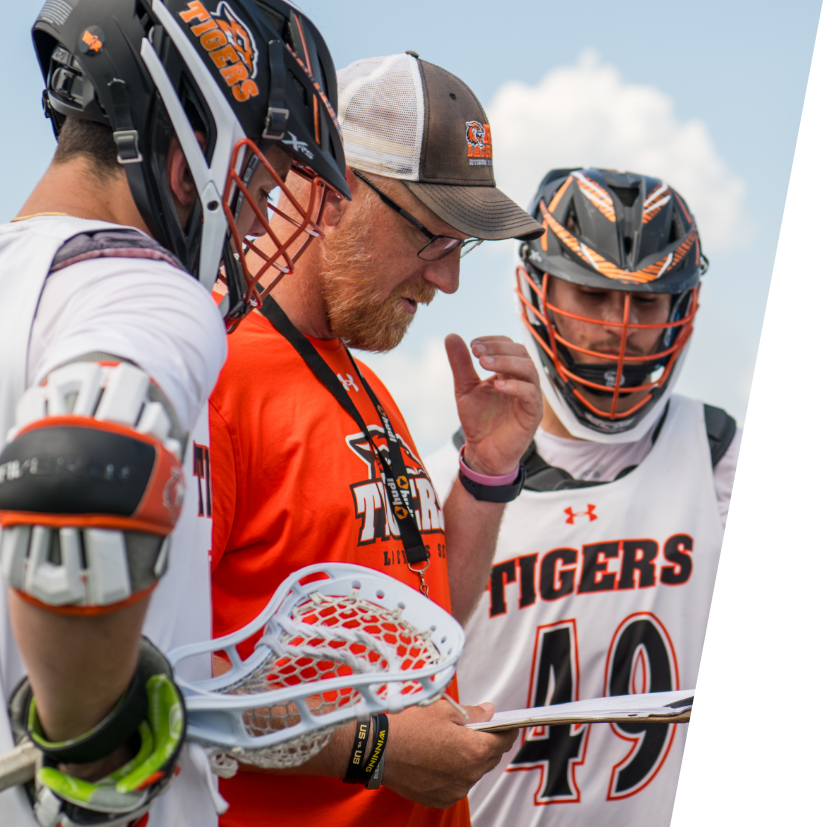
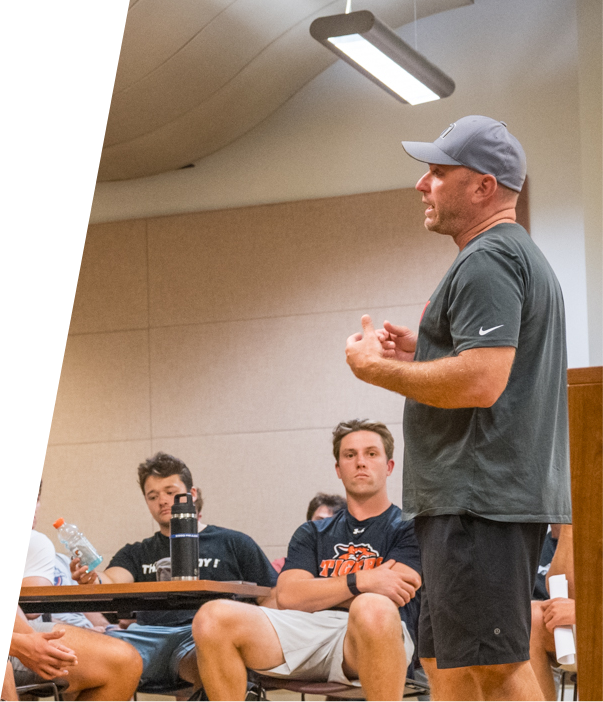
Building a program
Coon’s teams have continued to excel, losing no more than three times a season since that first year.
By his side the entire time has been assistant coach Shawn Wilkins ’02 (hospitality and service management).
“Jake is the father figure, and I am kind of like the uncle,” Wilkins said. “We balance each other out really well. Jake is super organized. He is very detailed, very thorough. I am more creative. I allow guys a little more freedom. I am allowed to do that because I am the offensive coach.”
Three years after Coon and Wilkins started, the Tigers played for the national championship.
They won the national title for the first time in 2021 in a double overtime thriller against Salisbury University.
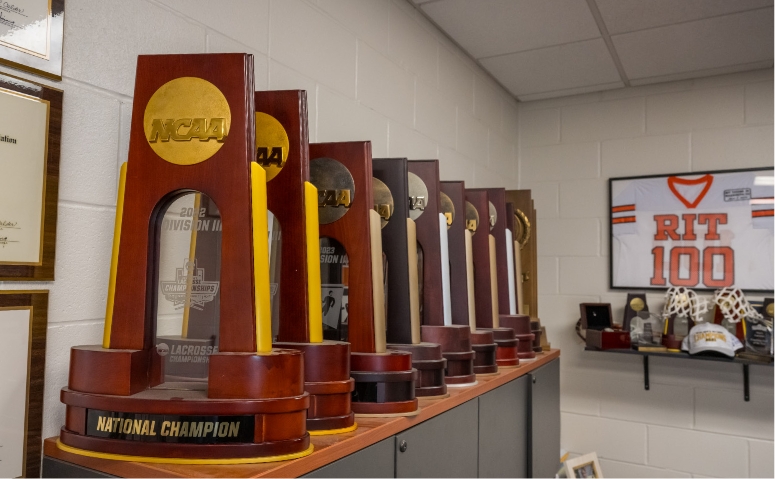
By the numbers
Men’s lacrosse under Coach Jake Coon
- .90301 – Coon’s winning percentage, the highest of all time ahead of Salisbury University Coach Jim Berkman at .90282
- 270 – wins, the most in program history
- 5 – national championship game appearances in 2013, 2017, 2021, 2022, 2024
- 2 – national championships in 2021 and 2022
- 10 – NCAA Final Four appearances
- 14 – straight NCAA Tournament appearances — there was no NCAA Tournament in 2020
- 108 – All-Americans
- 2 – national players of the year
Alex Maruna ’21 (mechanical engineering) said that was a once-in-a-lifetime event for him and other seniors following the COVID-19 pandemic. It also was special because during his first year on the team, they lost the championship to Salisbury.
They were successful, Maruna said, in part because players kept the game in perspective. They focused on being thankful for the opportunity to participate in a championship instead of the stress of the national stage. The team even visited Dave & Buster’s arcade before the game to “stay loose and happy.”
Maruna said he learned from Coon how to push through when things get tough, how to prioritize, and how to set a high standard of excellence—skills he uses in his job as a senior engineer at Enica Engineering in New York City.
“He adapts to the people in the locker room, people’s strengths and their weaknesses,” said the defensive player, who spent a lot of time with Coon. “He isn’t stuck on what he has done in the past. He is pushing to get the most potential out of each guy.”
Wilkins said a unique aspect of RIT men’s lacrosse is that there is no hierarchy among the players.
“There are 58 guys in that locker room, and they are all equal. If you are a freshman, you can be yourself right away. You don’t have to wait until junior year or senior year to break out of your shell.”
It’s a culture people want to join. On a recent afternoon, Coon scrolled through pages and pages of players from all over the United States and Canada who want to come to RIT.
Every athlete wants to play for a successful program, said Jack Langan, chair of the Division III Student-Athlete Advisory Committee, a national group that provides insight on the student-athlete experience.
“Top-tier programs often bring in top students,” Langan said. “The competitive drive to succeed on the field frequently bleeds into the academic world, leading to high-performing students.”

This high-performing culture in some ways is just beginning. Both Coon and Wilkins said they want to get back to the national championship game, which they lost last season to Tufts University in Philadelphia.
Next academic year, the team will play in a new $30 million stadium. Every year, Coon said, he and his coaches will focus on continuing to improve the program, as well as growing an active alumni base. Coon corresponds with nearly 700 alumni and friends of RIT lacrosse regularly.
“We will continue to develop young men into great citizens. We will continue to excel off the field, in the classroom, and in the community,” Coon said. “Some of those things are a little more important than wins and losses. I think those are important too, don’t get me wrong. We want to win. But I think the bigger picture is just as important.”
Athletic Director Nicholson said Coon has been recruited for Division I coaching positions but he has stayed because he is invested in the local community and RIT.
Coon said he has no plans to leave.
“I have thought about it for a brief second,” he said. “You know what, I am taken care of here. I feel appreciated here. I am in a good place.”

New Tiger Stadium Coming Soon
The $30 million Tiger Stadium, which will become the home of men’s and women’s lacrosse and soccer teams, is expected to open in January 2026.
The 38,828-square-foot facility will seat 1,180, with additional capacity in the hospitality room, along with standing room.
Amenities for the new stadium include team locker rooms; a training room with two large hot and cold tubs, taping tables, and exam tables; media suite; concession area; hospitality room with glass viewing wall; and an outdoor concourse.
The stadium architect is LaBella Associates, with support in the design process by Populous, a nationally recognized stadium design firm. Construction is being managed by Pike Construction Services.








